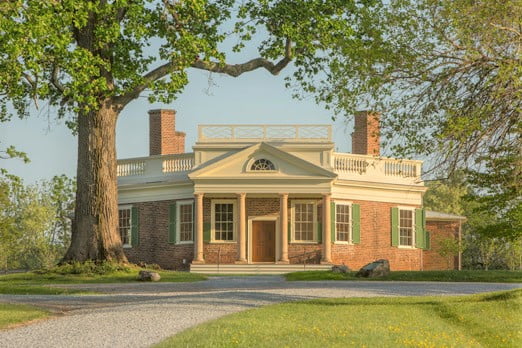
Thomas Jefferson’s Poplar Forest began a gradual reopening to the public on Saturday, June 6, as Virginia enters Phase II of Governor Ralph Northam’s “Forward Virginia Plan.”
In this initial phase, the octagonal villa will be open for three guided tours per day during limited hours on Thursday through Sunday only. Visitors to Poplar Forest this summer will be among the first to see Jefferson’s newly restored carriage turnaround; view a new orientation film about Thomas Jefferson and his time at the plantation; experience the villa on a new tour with time to explore the house at their own pace and observe the restoration work in progress as craftsmen continue to recreate the interior woodwork. The museum shop, newly restocked for the season, will also be open to shoppers seeking special souvenirs or gifts.
“We very much look forward to welcoming visitors back onsite,” said Alyson M. Ramsey, president and CEO of Poplar Forest. “We’ve been hard at work since our closure in mid-March and can’t wait to share our progress. We want the public to know that the safety of our visitors, staff and volunteers is our greatest priority. We’ve implemented several new precautions and procedures and sincerely appreciate our visitors’ cooperation with these requirements.”
All visitors must maintain social distancing protocols and wear masks while on tours and in public buildings. The admissions desk will also move to a temporary location on the patio outside of the museum shop. Additional precautions will be taken inside the museum shop, the visitor orientation center and public restrooms.
Guided tours of the villa will be offered at 11 a.m., 1 p.m. and 3 p.m. Thursday through Sunday, and will be strictly limited to a maximum of 10 people. Visitors are encouraged to purchase tickets in advance to ensure their spot on the tour.
Guests can also book one of the two private tours offered at 11:30 a.m. and 2:30 p.m. each day. Admission fees for private tours are $25 for adults (ages 18+), $14 youth (ages 6-17) and free for children under age 6. Private tours must be reserved 24 hours in advance through the museum shop.
Admission to Poplar Forest includes a guided house tour and a self-guided exploration of exhibits in the lower level of the house, the wing of offices, the ornamental grounds and the slave quarter site. Enslaved community tours, which provide additional insight into the world and life of the enslaved residents, are offered at no extra cost when a docent is available.
General admission fees are $18 for adults; $16 for seniors (ages 65+) and military (must show ID); $10 for college students (must show ID) and teens (ages 12-18); $6 for youth (ages 6-11); and free for children under age 6 and Poplar Forest members.
For more information or to purchase admission tickets for a guided tour of Thomas Jefferson’s Poplar Forest, contact the museum shop at 434-534-8120, or visit poplarforest.org.
About Poplar Forest
One of only two homes Thomas Jefferson designed for his personal use, the Poplar Forest retreat was the place where Jefferson “came to indulge in the life of the mind and renew his personal creativity.” Jefferson and his wife, Martha, inherited the Bedford County plantation known as Poplar Forest from her father in 1773. When his presidency ended in 1809, Jefferson visited the retreat three or four times a year, often staying for several months at a time during planting seasons.
Designated a National Historic Landmark by the Secretary of the Interior, and nearly lost to development, Thomas Jefferson’s Poplar Forest plantation in the foothills of the Blue Ridge Mountains was rescued in 1984 by a group of local citizens who sought to preserve it for the cultural and educational benefit of the public. Poplar Forest was opened to the public for the first time in 1986, in its “before restoration” state.
Today, the neoclassical architecture of the octagonal house has been returned to Mr. Jefferson’s design. The National Trust for Historic Preservation has recognized the meticulous research and restoration efforts with its highest award, and the plantation has been nominated as a UNESCO World Heritage Site. A visit to Poplar Forest offers a unique opportunity to observe a “live” archaeological dig and historic restoration in progress, as efforts to reveal and restore Thomas Jefferson’s vision for his personal retreat continue.

